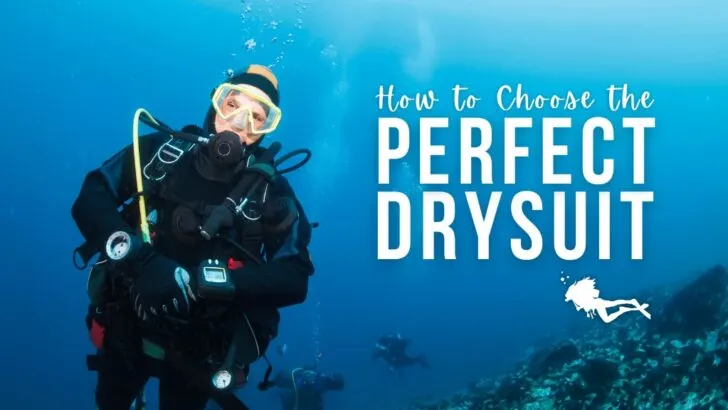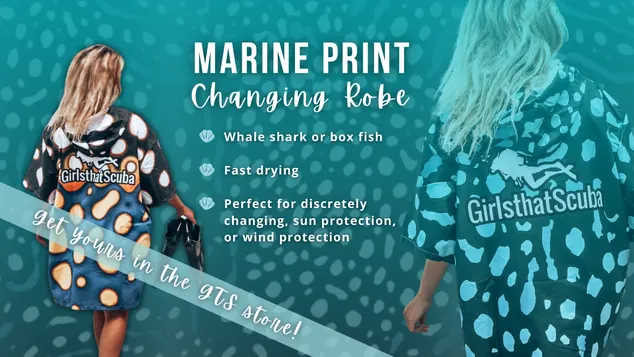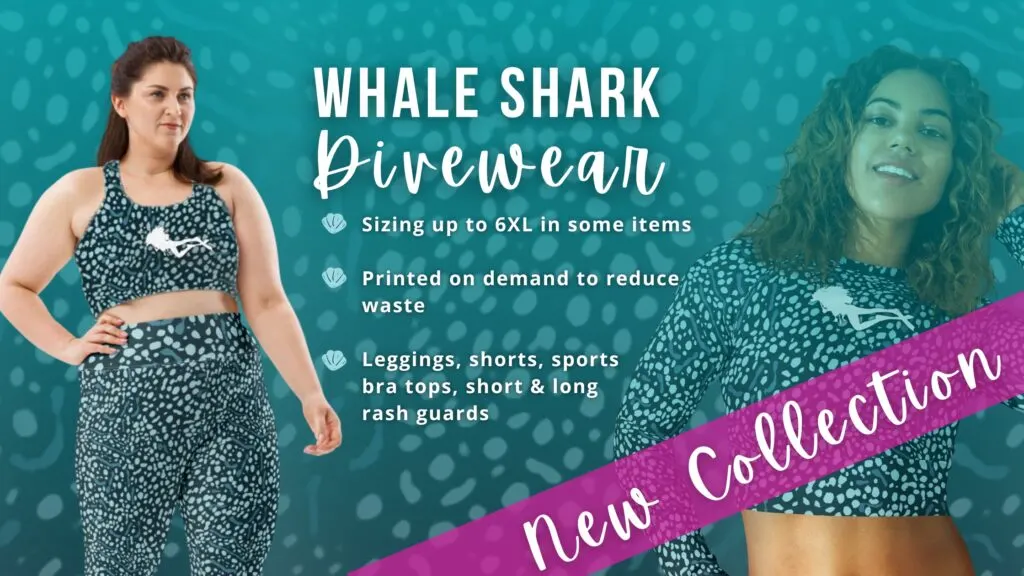We can’t be diving in warm tropical waters all the time, and some of the best sights to be seen are found in much cooler climes. So what do we do when we need to keep warm underwater? Don a drysuit, of course! But with so many decisions to make, it’s not easy to know how to choose a drysuit.
With the wisdom from our Girls that Scuba community, we’re here to help you with how to choose a drysuit. Let’s jump in to everything you need to know about drysuit materials, drysuit undergarments, customisations, and more!
Trilaminate vs Neoprene Drysuits
The first thing to consider when you’re shopping for a new drysuit is what material to choose. The two most common drysuit styles are trilaminate (also called membrane) suits, and neoprene drysuits. Both have their advantages and disadvantages for different types of diving.
Membrane or trilaminate drysuits are constructed from a triple layered fabric. These feature a waterproof rubber centre with flexible fabrics on either side. This is usually nylon or similar, but commercial or technical drysuits can also be layered with Kevlar for its hard wearing properties.
Trilaminate suits are generally bulkier, with more of an airspace between the diver and the suit. Trilam has little insulating power on it’s own, and it’s actually the undergarments which will keep you warm underwater.
You can customise these layers depending on the water temperature. This makes it a great option for those who dive in areas where the water temperature fluctuates throughout the year (such as UK diving).
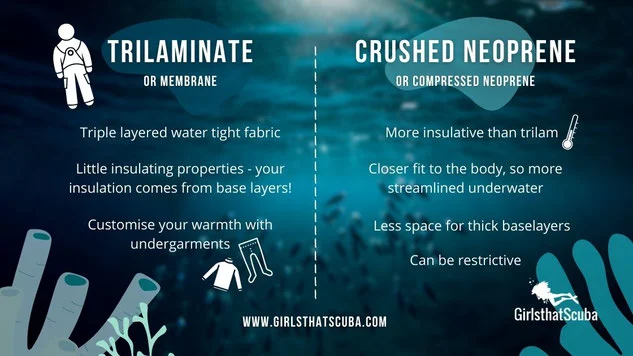
Crushed or compressed neoprene has stronger insulative properties alone than trilaminate. As they don’t need to leave as much space for thick undersuits, neoprene drysuits have a much closer fit than membrane suits. This means the diver is more streamlined underwater, moving more efficiently with less drag than in a trilaminate suit.
Crushed neoprene is naturally more buoyant than trilaminate, and some see this as the main downside to neoprene. However, the additional layers needed underneath a trilaminate suit can also be just as buoyant.
We recommend talking to other drysuit divers in the location you plan to dive to work out which combination of suit material and undersuit will work best for you.
Choosing Drysuit Undergarments
When thinking about drysuits, you should consider your suit itself and the undergarments as equally important. It’s a full exposure suit system, rather than the suit doing all the work on its own.
The most important properties with drysuit undergarments are insulation and wicking, which means drawing moisture (sweat) away from the body. Natural fibres are generally best for this, with merino wool being a popular choice.
Undersuits used to be thick and bulky, but fabrics have come a long way. You will now find endless options of customisable layers which are less buoyant, have stronger insulative properties, and are much easier to wash.
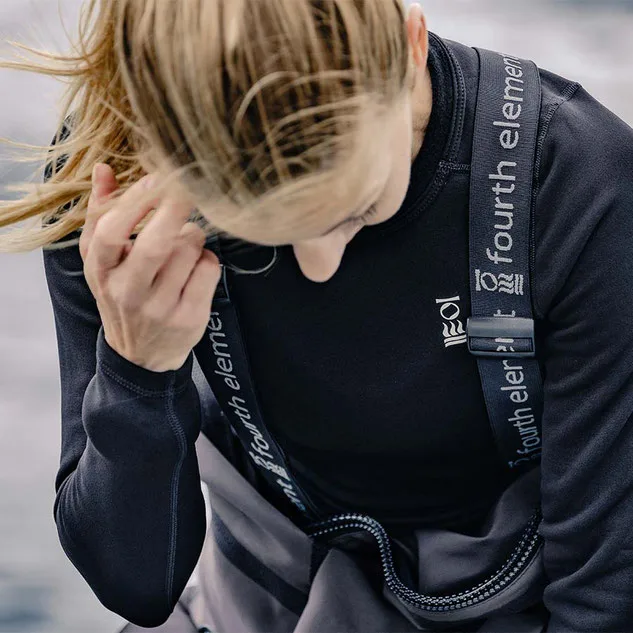
Fourth Element drysuit undergarments are always some of the most highly recommended. They have a whole wardrobe of customisable base layers available. This means you can choose based on the water temperature and your personal cold tolerance.
The toasty Fourth Element Arctic layers are perfect for underneath trilaminate suits. For neoprene drysuit users, check out their thinner Xerotherm top and leggings.
Bare’s drysuit layers are also popular within the GTS community, with their SB Mid Layers and Ultrawarmth Base Layers being particular favourites.
Custom Fit Drysuits
Fit is one of the most important factors when choosing any scuba diving equipment. This is particularly true for exposure suits. If a wetsuit or drysuit doesn’t fit you well, it won’t keep you as warm as it should.
With drysuits you have the added consideration of buoyancy. If a drysuit doesn’t fit well, areas of extra air can make it really challenging to get your buoyancy right. It can even be potentially dangerous. If you end up with large air pockets in your legs for example, it can make you more likely to end up in a feet-up runaway ascent.
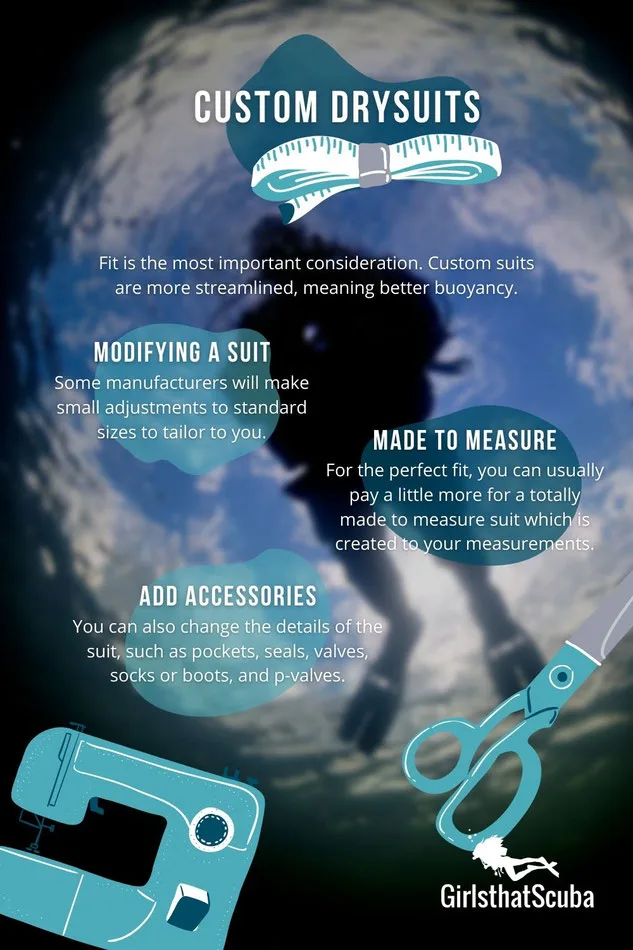
With this in mind, most drysuit manufacturers will offer a tailoring service to achieve the perfect drysuit fit. This often means adapting their off the peg suits with some modifications. Some brands offer this for free, but most charge a small additional cost.
For a truly perfect fit, look for completely made to measure suits. This can also come at an extra cost, but it will be worth it to have a suit which is perfectly made for you. This is also a great option for plus size divers.
Custom Drysuit Accessories
It’s not just the sizing that’s worth customising. Choosing your own accessories means you can make your drysuit truly perfect for you. Here are some of the elements which you can often customise when it comes to ordering a drysuit.
Seals
There are a few different materials and styles to choose from for drysuit seals. You can choose between latex, silicone, and neoprene seals. Neoprene seals will often need to be folded in on themselves to create a watertight seal, which can be finicky. However, neoprene can be more comfortable.
Latex and silicone seals often offer a better watertight seal than neoprene, but they can be more irritating on the skin. You’re generally able to cut these seals yourself, making them even more customisable than neoprene.
Gloves
When it comes to gloves for drysuit wearers, there are two main types. The standard option is to have seals on the wrists, which then gives you the freedom to choose neoprene gloves to suit the temperature you’re diving in. This could be anywhere from 3mm up to thick 7mm+ mittens.
However, the preferred option for many is to install a dry glove system. This means opting for slightly different wrist seals, as you’ll need rings in place to be able to add dry gloves. By choosing dry gloves, you can add layers underneath as needed.
Boots
Just like with gloves, there’s a choice for boots. Many suits will come with neoprene socks as standard, which aren’t necessarily custom-sized for your feet. For an extra fee, you can often upgrade to integrated boots. This generally ends up more comfortable.
Additionally, choosing the standard sock option means you need to be a bit more cautious with your drysuit. Walking around with no boots on over the top puts you at risk of creating holes which lead to leaks – and no-one wants a wet drysuit!
Valves
Many manufacturers will give you different options for valves. This might include placement and brand, amongst other choices.
You also may have the option to add a p-valve, which can be a great addition for anyone who may be doing longer dives such as cave dives or tech dives. A p-valve, in combination with a She-P, means you’ll be able to relieve yourself underwater.
Pockets
Most drysuits have pockets, usually found on the thigh, and custom drysuits will often offer options for these pockets. This might mean choosing between different sizes, whether you want one pocket or two, or which side they’re placed on.
Thinking about the accessories you want to carry as well as whether you’re left or right handed will help you to decide what pockets to get and where!

